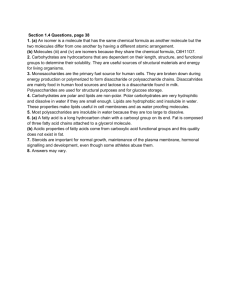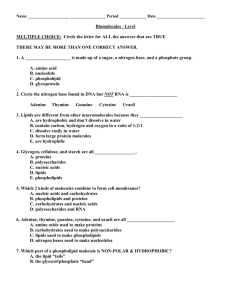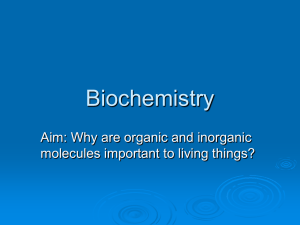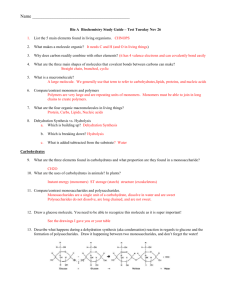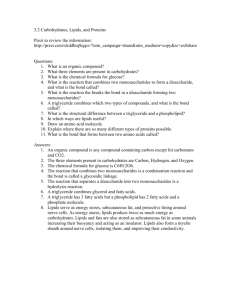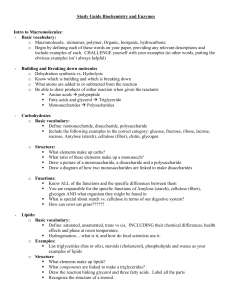Bio J Carbs and Lipids Review
advertisement
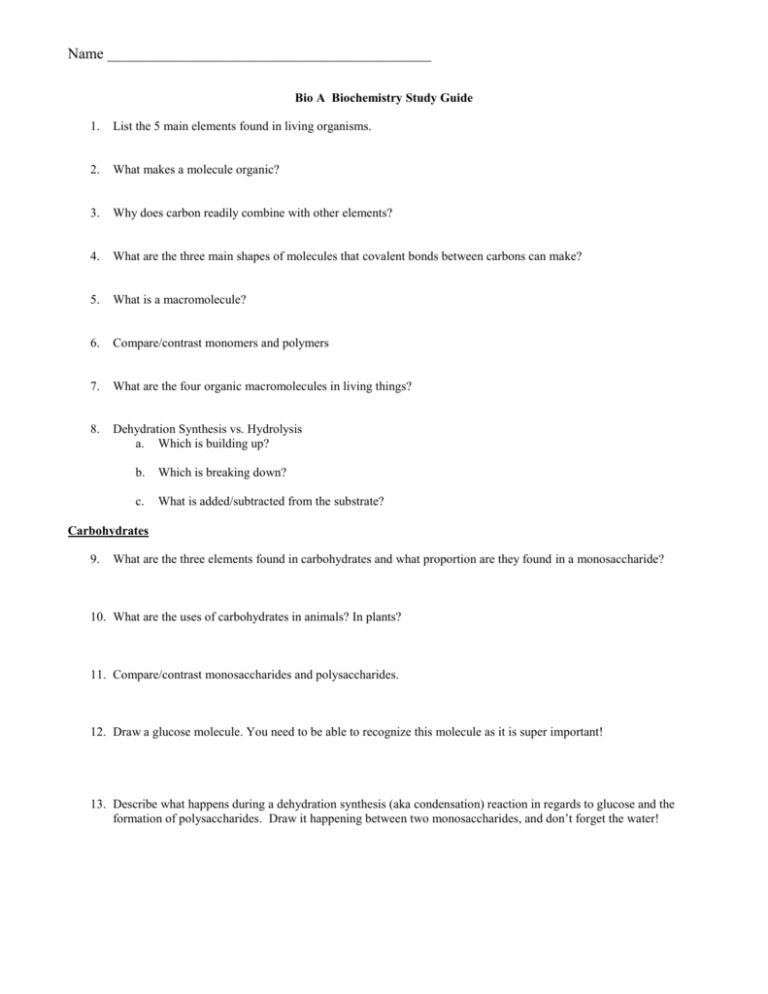
Name ___________________________________________ Bio A Biochemistry Study Guide 1. List the 5 main elements found in living organisms. 2. What makes a molecule organic? 3. Why does carbon readily combine with other elements? 4. What are the three main shapes of molecules that covalent bonds between carbons can make? 5. What is a macromolecule? 6. Compare/contrast monomers and polymers 7. What are the four organic macromolecules in living things? 8. Dehydration Synthesis vs. Hydrolysis a. Which is building up? b. Which is breaking down? c. What is added/subtracted from the substrate? Carbohydrates 9. What are the three elements found in carbohydrates and what proportion are they found in a monosaccharide? 10. What are the uses of carbohydrates in animals? In plants? 11. Compare/contrast monosaccharides and polysaccharides. 12. Draw a glucose molecule. You need to be able to recognize this molecule as it is super important! 13. Describe what happens during a dehydration synthesis (aka condensation) reaction in regards to glucose and the formation of polysaccharides. Draw it happening between two monosaccharides, and don’t forget the water! 14. What are the three main types of complex carbohydrates (aka polysaccharides) that are made by plants and animals and what is each used for? 15. What is the significance of the way cellulose monomers are bonded together when it comes to an animal trying to digest cellulose? 16. How have certain types of animals (think termites and cows!) gotten around the indigestible nature of cellulose? Lipids 17. What elements are found in lipids? Is there a set ratio? 18. Why is there more potential energy in lipids than in carbohydrates (per gram)? 19. What are the main uses of lipids in animals and plants? 20. Why do animals use lipids instead of glycogen for long term energy storage? 21. Be able to identify the following. You won’t be asked to draw them, but you must be able to recognize them, so draw them now just to be sure. You will also need to be able to tell me about their functions, so do that here, too. Fatty acid (saturated and unsaturated) Glycerol Triglyceride Steroid (cholesterol) Phospholipid show one of these and how they group in a membrane 22. Explain a dehydration synthesis reaction by combining 3 fatty acids and a glycerol molecule. Label the end product 23. Are lipids polar or non-polar and what does this mean in regards to H20? 24. What are poly- and mono-unsaturated fatty acids? Proteins 25. How many amino acids are there? 26. What elements are found in amino acids? (significance for diet?) 27. Why are some aa essential and some non-essential? 28. Draw an amino acid and identify the carboxyl group and the amino groups. 29. What is a peptide bond and how is peptide bond formation different than dehydration synthesis in carbohydrates and lipids? 30. Describe the four levels of a protein’s structure. 31. What does the term “denaturation” mean in regards to proteins? How does it affect protein function? 32. How do living organisms “know” the order of amino acids when putting together (synthesizing) new proteins? Nucleic Acids 33. What are they used for? 34. What is the monomer unit? 35. What are the two types of nucleic acids? STUDY YOUR NOTES AND PACKETS!!!!!!! ANYTHING IN NOTES/BOOK IS FAIR GAME!
